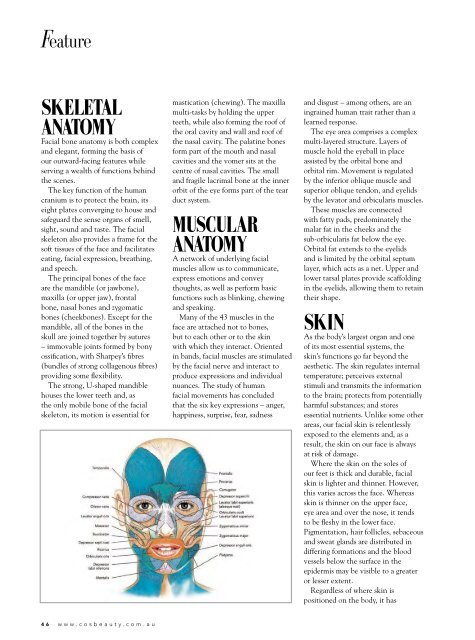CosBeauty Magazine #81
CosBeauty is the #BeautyAddict's guide to lifestyle, health and beauty in Australia. In this issue we look at: • Essential Exfoliation - Smooth Skin for Spring • Why your Beauty Sleep is really important • 40 over 40 - Anti-ageing must have products • Tassie Road Trip • Lauren Hannaford - FHIT for Life • Face Value - Facial Surgeries explained
CosBeauty is the #BeautyAddict's guide to lifestyle, health and beauty in Australia. In this issue we look at:
• Essential Exfoliation - Smooth Skin for Spring
• Why your Beauty Sleep is really important
• 40 over 40 - Anti-ageing must have products
• Tassie Road Trip
• Lauren Hannaford - FHIT for Life
• Face Value - Facial Surgeries explained
Create successful ePaper yourself
Turn your PDF publications into a flip-book with our unique Google optimized e-Paper software.
Feature<br />
Skeletal<br />
anatomy<br />
Facial bone anatomy is both complex<br />
and elegant, forming the basis of<br />
our outward-facing features while<br />
serving a wealth of functions behind<br />
the scenes.<br />
The key function of the human<br />
cranium is to protect the brain, its<br />
eight plates converging to house and<br />
safeguard the sense organs of smell,<br />
sight, sound and taste. The facial<br />
skeleton also provides a frame for the<br />
soft tissues of the face and facilitates<br />
eating, facial expression, breathing,<br />
and speech.<br />
The principal bones of the face<br />
are the mandible (or jawbone),<br />
maxilla (or upper jaw), frontal<br />
bone, nasal bones and zygomatic<br />
bones (cheekbones). Except for the<br />
mandible, all of the bones in the<br />
skull are joined together by sutures<br />
– immovable joints formed by bony<br />
ossification, with Sharpey’s fibres<br />
(bundles of strong collagenous fibres)<br />
providing some flexibility.<br />
The strong, U-shaped mandible<br />
houses the lower teeth and, as<br />
the only mobile bone of the facial<br />
skeleton, its motion is essential for<br />
mastication (chewing). The maxilla<br />
multi-tasks by holding the upper<br />
teeth, while also forming the roof of<br />
the oral cavity and wall and roof of<br />
the nasal cavity. The palatine bones<br />
form part of the mouth and nasal<br />
cavities and the vomer sits at the<br />
centre of nasal cavities. The small<br />
and fragile lacrimal bone at the inner<br />
orbit of the eye forms part of the tear<br />
duct system.<br />
Muscular<br />
anatomy<br />
A network of underlying facial<br />
muscles allow us to communicate,<br />
express emotions and convey<br />
thoughts, as well as perform basic<br />
functions such as blinking, chewing<br />
and speaking.<br />
Many of the 43 muscles in the<br />
face are attached not to bones,<br />
but to each other or to the skin<br />
with which they interact. Oriented<br />
in bands, facial muscles are stimulated<br />
by the facial nerve and interact to<br />
produce expressions and individual<br />
nuances. The study of human<br />
facial movements has concluded<br />
that the six key expressions – anger,<br />
happiness, surprise, fear, sadness<br />
and disgust – among others, are an<br />
ingrained human trait rather than a<br />
learned response.<br />
The eye area comprises a complex<br />
multi-layered structure. Layers of<br />
muscle hold the eyeball in place<br />
assisted by the orbital bone and<br />
orbital rim. Movement is regulated<br />
by the inferior oblique muscle and<br />
superior oblique tendon, and eyelids<br />
by the levator and orbicularis muscles.<br />
These muscles are connected<br />
with fatty pads, predominately the<br />
malar fat in the cheeks and the<br />
sub-orbicularis fat below the eye.<br />
Orbital fat extends to the eyelids<br />
and is limited by the orbital septum<br />
layer, which acts as a net. Upper and<br />
lower tarsal plates provide scaffolding<br />
in the eyelids, allowing them to retain<br />
their shape.<br />
Skin<br />
As the body’s largest organ and one<br />
of its most essential systems, the<br />
skin’s functions go far beyond the<br />
aesthetic. The skin regulates internal<br />
temperature; perceives external<br />
stimuli and transmits the information<br />
to the brain; protects from potentially<br />
harmful substances; and stores<br />
essential nutrients. Unlike some other<br />
areas, our facial skin is relentlessly<br />
exposed to the elements and, as a<br />
result, the skin on our face is always<br />
at risk of damage.<br />
Where the skin on the soles of<br />
our feet is thick and durable, facial<br />
skin is lighter and thinner. However,<br />
this varies across the face. Whereas<br />
skin is thinner on the upper face,<br />
eye area and over the nose, it tends<br />
to be fleshy in the lower face.<br />
Pigmentation, hair follicles, sebaceous<br />
and sweat glands are distributed in<br />
differing formations and the blood<br />
vessels below the surface in the<br />
epidermis may be visible to a greater<br />
or lesser extent.<br />
Regardless of where skin is<br />
positioned on the body, it has<br />
46 www.cosbeauty.com.au

















